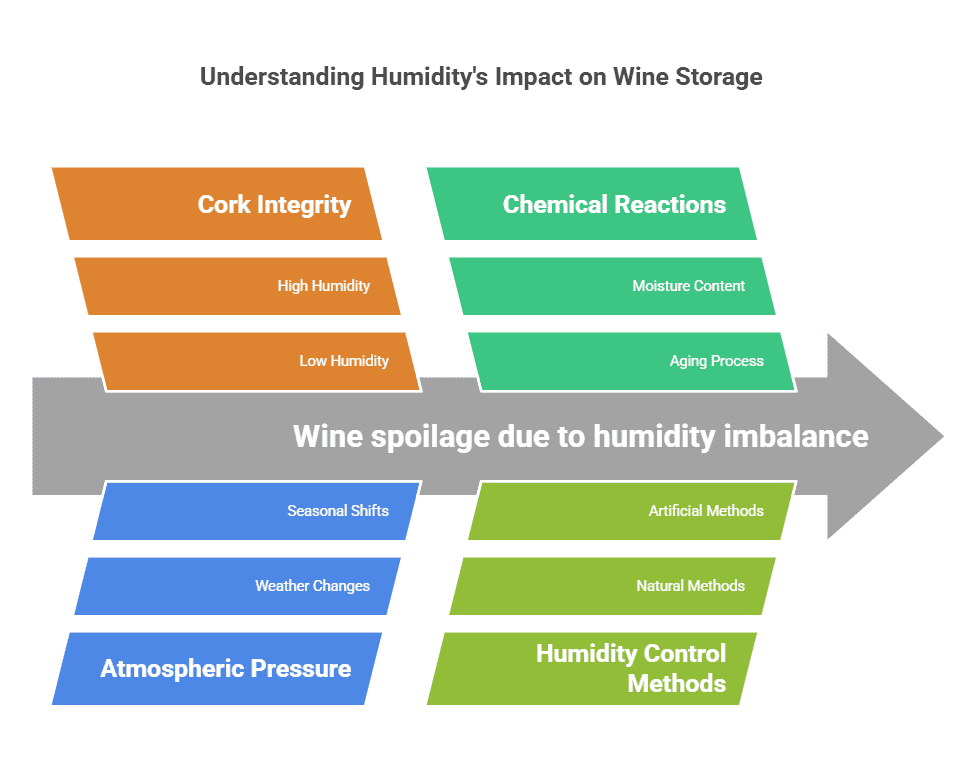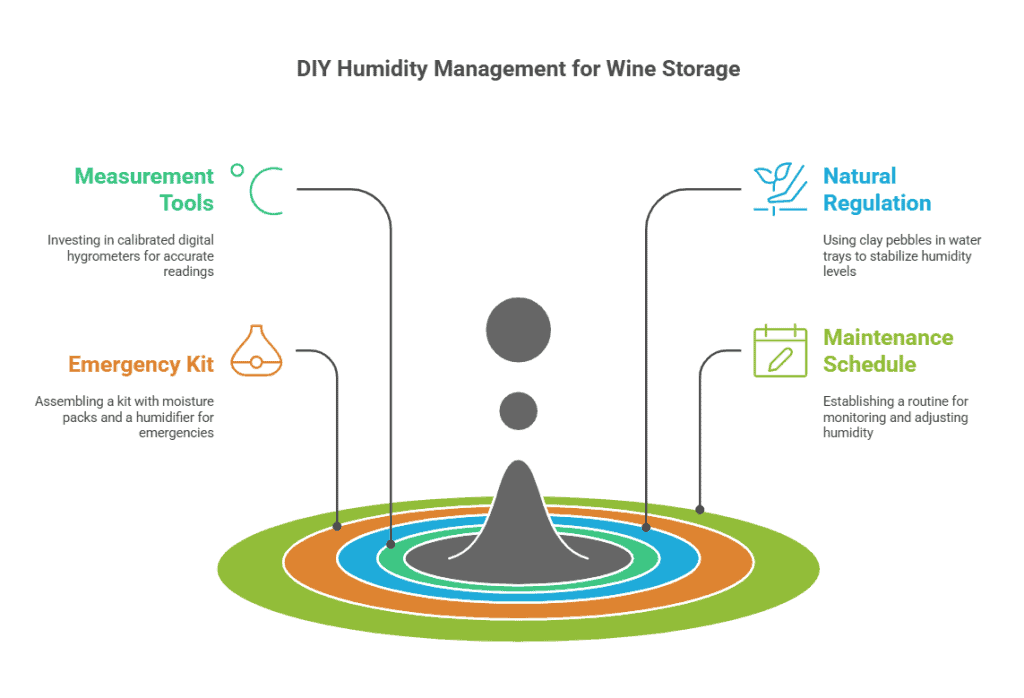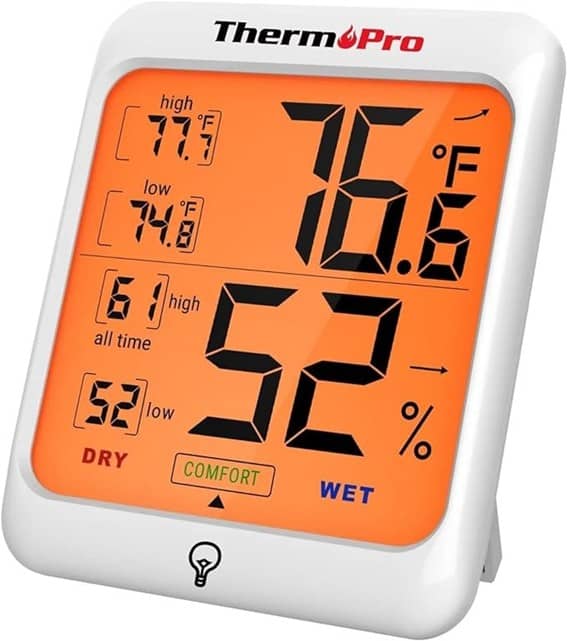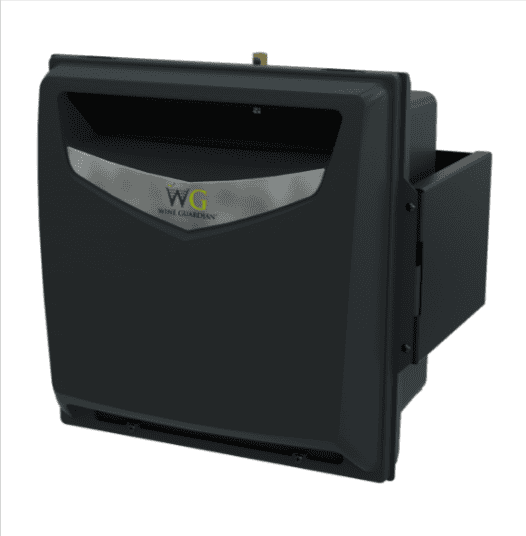Did you know that improper humidity levels can cost wine collectors thousands of dollars in damaged collections?
As a wine enthusiast and storage expert, I’ve seen countless collections compromised by poor humidity control. Today, I’ll share everything you need to know about maintaining the perfect wine storage humidity for your precious wines.
According to a recent study by the International Wine Storage Association, over 35% of wine collections experience some form of humidity-related damage during their aging process. Let’s dive into why wine storage humidity control is non-negotiable!
Welcome to Didi Somm, and Cheers!
Important Notice: The information in this article is for general and public information purposes only. It solely reflects Didi Somm’s or his Staff’s opinion, and no responsibility can be assumed for errors or omissions in the service’s contents. For details, please check the Disclaimer at the bottom of the homepage.

Key Takeaways
- Optimal wine storage humidity ranges from 60-70%
- Consistent humidity levels are as crucial as temperature control
- Low humidity can dry out corks, leading to wine oxidation
- High humidity can damage labels and promote mold growth
- Professional-grade humidity monitoring systems are essential for valuable collections
Understanding the Science Behind Wine Storage Humidity
After 15 years of managing wine storage facilities, I’ve learned that understanding humidity’s role in wine storage isn’t just about following numbers – it’s about grasping the fascinating science behind it. Let me tell you about the time I lost a valuable bottle of 1982 Bordeaux due to a dried-out cork, which taught me a crucial lesson about humidity’s relationship with cork integrity. The cork, which should have remained plump and sealed, had shrunk due to low humidity, allowing oxygen to seep in and spoil the wine.
The science is actually quite fascinating. Think of your wine cork as a natural sponge that’s constantly interacting with its environment. When humidity levels drop below 60%, the cork begins to lose moisture, causing it to contract and potentially break the seal. Conversely, too much humidity can cause the cork to expand excessively, potentially pushing it out slightly and compromising the seal.
Atmospheric pressure plays a more significant role than most collectors realize. I’ve noticed that during significant weather changes, especially in regions with dramatic seasonal shifts, the pressure variations can affect how the wine ages. This is particularly noticeable in underground cellars, where the natural atmospheric pressure changes can actually influence the micro-oxygenation process through the cork.
The chemical reactions happening inside your wine bottles are incredibly sensitive to moisture content in the surrounding air. Trust me, I learned this the hard way when monitoring different storage environments. When humidity levels fluctuate, it can speed up or slow down the aging process, affecting everything from tannin development to acid balance.
Here’s something many don’t realize: Natural humidity control methods can sometimes outperform artificial ones. In my early days, I was all about high-tech solutions, but I’ve come to appreciate the effectiveness of passive humidity control in well-designed cellars. Nature’s pretty smart that way!

Affiliate Disclaimer: This page may include Affiliate links, meaning that we get a commission if you decide to purchase through this site at no extra cost to you. Please read our Disclaimer for your info.
Optimal Humidity Levels for Wine Storage
Let me share something I wish I’d known when I first started collecting wine: maintaining optimal humidity isn’t just about hitting a magic number – it’s about consistency and understanding your specific storage environment. Through years of monitoring different cellars, I’ve found that the industry-standard range of 60-70% humidity exists for good reason, with 65% being the sweet spot that’s worked best in my experience.
What really opened my eyes was working with collectors in different regions. A cellar in Arizona faces completely different challenges than one in Florida. In drier climates, you might need to work harder to maintain minimum humidity levels, while in humid areas, the challenge is often preventing excess moisture. I once had to completely redesign a client’s cellar system because we didn’t account for their coastal location’s natural humidity patterns.
When it comes to storage duration, here’s something crucial I’ve learned: short-term storage (less than 5 years) can tolerate slightly wider humidity ranges, but for long-term aging, staying close to that 65% mark becomes critical. I’ve seen collections stored for decades maintain perfect condition when kept at consistent humidity levels.
Different wine types actually show varying sensitivity to humidity fluctuations. Red wines, especially those meant for long-term aging, tend to be more affected by humidity variations than younger whites. This became crystal clear when I compared two cases of the same vintage stored at different humidity levels for five years – the difference in cork condition was remarkable.
Recent scientific studies have backed up what we’ve observed in practice. Research from leading wine institutes has shown that maintaining humidity between 60-70% not only preserves cork integrity but also creates optimal conditions for the complex chemical reactions involved in wine aging. These findings have revolutionized how I approach humidity control in professional storage settings.
Summary – Humidity Level Factors
| Aspect | Details |
|---|---|
| Optimal Humidity Range | Maintain humidity levels between 60-70% for proper wine storage. |
| Sweet Spot for Humidity | Aim for 65% humidity, which is ideal for consistent results in most environments. |
| Regional Challenges | Dry climates may require humidifiers, while humid areas might need moisture control. |
| Storage Duration | Short-term storage allows for wider humidity ranges, but long-term aging needs close to 65%. |
| Wine Type Sensitivity | Red wines for aging are more sensitive to humidity fluctuations than younger whites. |
| Scientific Evidence | Studies confirm that 60-70% humidity preserves cork integrity and supports wine aging. |
Common Humidity-Related Problems in Wine Storage
In my years of managing wine collections, I’ve seen just about every humidity-related disaster you can imagine. The most heartbreaking was discovering a client’s precious vintage collection with dried-out, crumbling corks – a harsh lesson in the importance of proper humidity control. Cork shrinkage is like a silent killer in wine storage; by the time you notice it, the damage is often already done.
Label damage is another major concern I’ve had to deal with. Nothing’s worse than watching a pristine label slowly deteriorate due to excess humidity. I remember one particularly painful incident where a collector’s entire Burgundy collection developed fuzzy mold on the labels, significantly reducing their value. The labels were perfectly preserved for decades until a humidifier malfunction created the perfect environment for mold growth.
Speaking of mold, let me tell you about the time I inherited the management of a cellar with serious mold issues. The previous owner had maintained humidity levels above 80%, thinking “more is better.” Wrong! Not only did we find mold on labels, but it had started affecting the cellar’s wooden shelving. This taught me that mold prevention isn’t just about the wine – it’s about protecting the entire storage environment.
One aspect that often gets overlooked is structural damage to the cellar itself. I’ve consulted on numerous cases where excessive humidity caused serious issues with walls, floors, and racking systems. In one memorable case, a collector’s custom-built cellar developed warped flooring and rusty fixtures because they didn’t properly balance their humidity control.
The impact on wine quality is what really keeps me up at night. Through years of tasting and comparing wines stored in various conditions, I’ve noticed that improper humidity levels can affect everything from the wine’s bouquet to its finish. Wines stored in overly dry conditions often show premature aging characteristics, while those kept in too-humid environments can develop off-putting musty notes.

Professional Humidity Control Solutions
After working with countless wine collectors, I’ve learned that professional humidity control is worth every penny when it comes to protecting valuable wine collections. My journey into professional systems began after a costly mistake with a basic home humidifier that failed overnight, nearly ruining a client’s precious Burgundy collection. That experience taught me the importance of investing in reliable, wine-specific humidity control solutions.
Humidification Systems
Modern humidification systems have come a long way, and I’m constantly amazed by their sophistication. The latest models I’ve installed use ultrasonic technology that maintains precise humidity levels without creating excessive moisture or heat. These systems can maintain that perfect 65% humidity level with minimal fluctuation, something that would have seemed like magic when I first started in this industry.
Smart Monitoring
Smart monitoring has been a game-changer in my consulting work. I remember the relief on a client’s face when I showed them how they could monitor their cellar’s humidity levels from their phone. The systems I now recommend include remote monitoring capabilities with alert features – something that saved one of my client’s collections during a power outage last summer. Pro Tip: Check the following link to the “SMART WINE CELLAR MONITORING App.”
Professional Installation
When it comes to professional installation, I’ve learned some hard lessons. One time, I thought I could save a client money by using a general HVAC contractor instead of a wine cellar specialist. Big mistake! The system was improperly sized and ended up creating cold spots that affected humidity distribution. Now I always stress the importance of working with certified wine cellar professionals who understand the unique requirements of wine storage.
Cost-Benefit Analysis
Looking at the cost-benefit analysis, I always tell my clients to consider the value of their collection. A $3,000 professional humidity control system might seem expensive, but it’s a small price to pay when protecting a $50,000 wine collection. I’ve seen collections literally saved by these systems, making them one of the best investments a serious collector can make.

DIY Humidity Management Techniques
Over the years, I’ve developed quite a few tricks for managing wine storage humidity on a budget. When I first started collecting wine, I couldn’t afford fancy humidity control systems, so I had to get creative. Let me share some proven DIY methods that have saved both my wine and my wallet!
The foundation of any DIY humidity management starts with reliable measurement tools. I always recommend starting with a good digital hygrometer – and yes, spend the extra money on calibration! I learned this lesson the hard way when my cheap hygrometer showed 65% humidity while my wine corks were literally crumbling. Now I use and recommend calibrated digital hygrometers with remote monitoring capabilities, which typically run about $30-50.
Natural humidity regulation has become something of a specialty of mine. One of my favorite techniques involves using food-grade clay pebbles in water trays. These pebbles increase the surface area for evaporation and help maintain more stable humidity levels than open water containers. I place these trays strategically around the storage area, usually near air circulation points for optimal effect.
For emergency situations, I’ve developed what I call my “humidity first aid kit.” It includes items like emergency moisture packs (similar to those used in cigar storage), plastic sheeting for temporary containment, and a small ultrasonic humidifier. Trust me, this kit has saved more than a few collections during sudden humidity drops or HVAC malfunctions.
The key to successful DIY humidity management is consistent monitoring and maintenance. I’ve created a simple schedule that I share with all my consulting clients: daily humidity checks (morning and evening), weekly water tray refills, monthly hygrometer calibration checks, and seasonal adjustments for changing weather conditions. This routine has helped countless collectors maintain proper humidity levels without breaking the bank.

FAQ – Wine Storage Humidity
- What is the ideal humidity level for storing wine? The ideal humidity level for wine storage is between 60-70%, with 65% being optimal.
- Can I store wine in my basement without humidity control? While possible, it’s risky without proper monitoring and control systems, as basement humidity can fluctuate dramatically.
- How often should I check wine cellar humidity? Daily monitoring is recommended, preferably with an automated system that provides continuous readings.
- What happens if wine storage humidity is too low? Low humidity can cause corks to dry out, leading to wine oxidation and spoilage.
- Can high humidity damage wine? Yes, excessive humidity can damage labels, promote mold growth, and potentially affect cellar infrastructure.
- What’s the best humidity monitoring device for wine storage? Digital hygrometers with remote monitoring capabilities are recommended for accurate measurements.
- How do I increase humidity in my wine cellar? Use a humidifier designed for wine cellars or natural methods like water containers with proper ventilation.
- Should humidity levels be different for red and white wines? No, all wines benefit from the same optimal humidity range of 60-70%.
- Are humidity fluctuations worse than consistent low/high humidity? Yes, fluctuations can be more damaging as they cause repeated expansion and contraction of corks.
- How does humidity affect wine aging? Proper humidity ensures optimal aging conditions by maintaining cork integrity and preventing oxidation.
- Can I use a regular home humidifier in my wine cellar? While possible, wine-specific humidifiers are recommended as they’re designed for cellar environments.
- What’s the relationship between temperature and humidity in wine storage? Temperature and humidity work together; changes in one often affect the other, requiring balanced control.
- How do I prevent mold in my wine cellar? Maintain proper ventilation and keep humidity below 70% while ensuring good air circulation.
- What’s the cost of professional humidity control systems? Professional systems typically range from $500-$3000, depending on cellar size and features.
- How long can wine survive in improper humidity conditions? While wine can survive brief periods of improper humidity, long-term exposure risks permanent damage.
Conclusion
Maintaining proper humidity levels in wine storage is crucial for preserving both the quality and value of your collection.
By implementing the right humidity control measures and regularly monitoring your storage environment, you can ensure your wines age gracefully and maintain their intended characteristics. Don’t wait for humidity-related problems to surface – take action now to protect your valuable wine investment.
From my experience, the cost of prevention is always lower than the cost of replacing damaged wines!
Enjoy your precious wine collection, and Cheers!
For reference, the latest articles by Didi Somm include:
- How To Organize Wine Fridge: Expert Guide 2025
- Best Wine Refrigerators For Every Budget: Expert Guide
- Insights on Long-term Wine Storage: Your Best Expert Guide
- 10 Essential Wine Aging Factors: All You Need To Know
- Wine Bottle Positioning: Best Expert Advice
- Impact Of Wine Temperature Fluctuations: Best Expert Guide
Important Notice: The information in this article is for general and public information purposes only. It solely reflects Didi Somm’s or his Staff’s opinion, and no responsibility can be assumed for errors or omissions in the service’s contents. For details, please check the Disclaimer at the bottom of the homepage.






